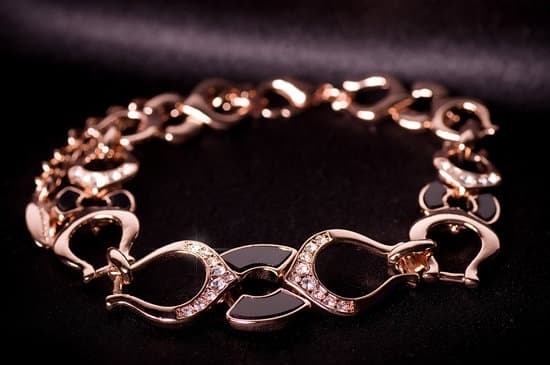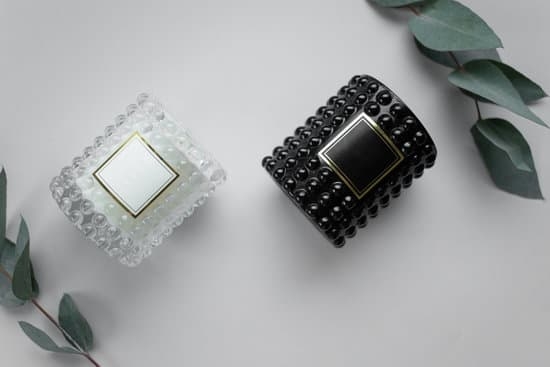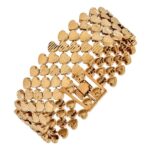Modern jewelry has been around for centuries, and the history of its development reveals how essential it has become over time. Jewelry has been crafted since ancient times, with the earliest pieces being made from simple objects such as shells, feathers, and beads. Gradually, more complex materials and techniques such as smelting metal ore began to be used in the creation of elaborately designed jewelry items.
It soon evolved into an art form that found its way into many different cultures and nationalities across the globe. Jewels were both symbols of power and status, but also an integral part of any person’s look – a testament to their wealth or class standing.
While modern fashion jewelry was a relatively late development compared to fine jewelry – which is often composed of expensive gemstones – it has eventually outstripped fine jewelry in terms of popularity among many people due to its affordability and creative designs. The introduction of plastic in the 19th century enabled manufacturers to create even more varied jewelry styles than ever before, allowing them to stay ahead of current fashion trends and appeal to customers who wanted something new.
As technology improved and new materials such as PVC became available over time, manufacturing processes became quicker and cheaper, allowing competition within this sector to increase drastically and driving down costs even further.
Today modern fashion jewelry is worn casually by millions all around the world. What started as a traditional craft has evolved into one of the most popular ways for people to express themselves through accessories.
From chunkystatement pieces to delicate charms necklaces, these pieces reflect personal aesthetics,whether classic or contemporarystyle influenced by various cultures around the world. Their flexibility makes them accessible for anyone regardless of their income levels or ages – creating an ever growing demand for fashion-forward statement jewellery that transcends traditional decoration rules into unique pieces that are inspiring generations despite social norms or economic constraints.
History of Ancient Jewelry
The history of modern jewelry dates back to ancient times, with origins in early civilizations. Jewelry has long played an important role in society and culture, used as a form of personal adornment, ritualistic worship, and symbolic communication between cultures.
Ancient jewelry typified a range of styles based on region, but mostly used precious materials such as gold, silver, and coloured stones like lapis lazuli, jasper, turquoise and Carnelian. These materials were often combined with different designs; for instance enameling was popularly used to create intricate patterns.
The use of ancient jewelry was widespread throughout the world from Africa to Asia and North America to Europe. It was used for multiple purposes including status symbols or as a way to signify membership of certain social roles such as warriors or rulers.
Additionally rituals featuring jewelry have been discovered amidst several civilizations’ religious ceremonies demonstrating their role in spiritual practices worldwide. Ancient jewelry pieces can still be found today within museums or even worshipped within certain religions since they are associated with deities or sacred sites.
In today’s world many fashion trends have been inspired by the styles originating from Ancient times; for example statement necklaces featuring barbaric designs popularly seen amongst Etruscan Jewelry is regularly used by high-end designers. Additionally mineral formations found during excavation of ancient cities continue to influence today’s market with semi-precious stones coveted around the globe contributing toward bespoke engagement rings and expensive watches alike.
Furthermore Gemstones believed to have spiritual powers are still used in alternative healing practices across different countries which can be traced back thousands of years ago when they were first used by shamans within tribal communities. In conclusion it is undeniable that Ancient Jewelry continues to inspire contemporary artisans providing us with timeless pieces that represent our diverse historical legacy despite the passing centuries that forged it.
Rise of Royal Jewelry
The development of jewelry began in the Middle Ages as a way for wealthy nobles to display their power and wealth. During this time period, jewels were used to adorn clothing, accessories, and more importantly, royals. Adorning oneself with expensive gems was indicative of royals’ high rank and power within society.
Many families who ruled during this time period created intricate designs using diamonds and rubies that are still studied today. Symbolic imagery such as crowns, lions, and flowering vines became common motifs in royal jewelry pieces, which usually represented an allegory to a ruler’s kingdom.
The rise of royal jewelry also brought about improvements in quality – gems were cut into precise shapes instead of simple polishing or leaving them uncut altogether. This rise in quality is evident in many of the pieces that have survived from medieval times through to the present day.
In addition to advancements in cutting techniques, there was also a shift towards precious metals being used instead of cheaper materials such as bronze or brass. Silver and gold dominated the gems being added and crafted into necklaces and rings that could be given as gifts during important state events or ceremonies within the court itself.
By modern standards, jewelry from the Middle Ages is often considered symbolic rather than beautiful; however it has left its mark on modern fashion through its influence on later trends such as Art Deco jewelry that began emerging around 1900s. The geometric shapes and vibrant gemstones used during this time trended heavily throughout Europe with lots of inspiration coming from past medieval designs.
This trend is still visible throughout many current fashion houses as well as smaller independent contemporary jewelers who apply traditional techniques to newer designs with modern twists making medieval-influenced statement pieces easy to find today.
Victorian Jewelry
Jewelry during the Victorian era, spanning from 1837 to 1901, had its own distinct styles, trends and craftsmanship that made it so recognizable. From this period emerged some of the most iconic pieces of jewelry such as snake rings, lockets, mourning pins, paste jewelry and lockets. These pieces showcased intricate details while strongly exhibiting the sentimental values of Queen Victoria’s reign at that time.
It was also during the Victorian era when many new metals were introduced in jewelry making such as gold plate and electroplating which were used often in combination with gems like turquoise and pearls. The craftsmanship of the jewelry makers was astonishing and they transformed these metals into works that would capture people’s fancy.
The trends during these times included things like dangling earrings with associated gemstones, layered necklaces adorning a pendant featuring a loved one’s portrait or handwriting, elaborate rings with precious stones to name a few. One can also identify distinct designs such as Renaissance revival which featured old Greek and Roman icons encrusted in metal or enameled gold frames as motifs for brooches or bracelets. All these styles contributed to inspiring modern day jewelry making enterprise.
Emergence of Modern Jewelry
The history of modern jewelry dates back to the mid-1800s when the industrial revolution began. As society’s manufacturing capacity increased, more and more materials were made available to craftspeople. The development of electricity allowed for new techniques such as electroplating, which could be used to coat other metals such as silver or gold onto a base metal.
During this time, many innovative new designs were created that incorporated elements of nature with art deco influences. This gave birth to a new era of jewelry design characterized by ornate and intricate pieces that looked and felt expensive but still maintained an affordable price tag.
Another key player in the emergence of modern jewelry is Tiffany & Co-founded in 1837 by Charles Lewis Tiffany and John B Young. Not only did they provide high-quality products, but their marketing also helped make jewelry culture more accessible to the public at large since they regularly advertised their goods in national magazines like Harper’s Bazaar and Vogue.
Through Tiffany & Co’s vast array of designs including Art Nouveau styling and neoclassicism, it was evident that quality fashion statement having pieces could look luxurious even on a budget.
Jewelry design continued to evolve through the 20th century thanks to influential designers like Jean Schlumberger, David Webb, and Earlene Bell who added new levels of creativity and imagination into pieces unlike anything seen before it. Pieces featured bold colors, playful motifs inspired by surrealism, rockabilly influences as well as elements from all around the world such as Chinese or Indian inspired designs or Parisienne vibes.
These advancements blended old traditions with modern style while setting a new standard for extravagant luxury fashion jewelry that’s still seen today amongst top designer labels such as Cartier or Van Cleef & Arpels.
Art Deco Jewelry
Art Deco jewelry is a design style that emerged in France during the 1920s, and although it lasted for just about two decades, it has been a major force in setting the fashion tone for jewelry of today. Art Deco was an art movement defined by its use of geometric motifs and designs, along with materials such as plastic and chrome.
For Art Deco Jewelry, gold and platinum were popular materials used to make some of the most beautiful pieces ever created.
The natural world became a common source of inspiration for many designers during the Art Deco period. Many pendants featured insect-like schemes and other abstract figures that paid homage to nature.
Moreover, their designs often emulated items found in nature like flowers or clam shapes which exuded drama and vitality that appealed to young women at the time. Women’s fashion accessories during this period often included geometric elements such as hoop earrings with diamonds set inside them or many seed pearls/diamond rings featuring elongated lines as well as tapered cabochon gemstones.
One woman who made her mark on this era of jewellery was Coco Chanel whose designs were highly sought after due to their modernistic yet feminine allure. Some iconic pieces from this designer were adorned with white crystals, quartz stones or colorless synthetic sapphires that represented elegance. The graphic lines of her jewelry had contrasting materials like jet paired with gold accents which remains popular today in high-end fashion jewelry collections.
Her bold style was copied by many designers around the world due to her success which inspired them to create more intricate designs in order to grab customers attention away from competitors. Notable among these intricate pieces are Snake Wrap Brooch necklace produced by Paul Flato which dissects among various prestigious pieces at auctions centuries later due to their unique grandeur.
Pop Culture Jewelry
Modern jewelry trends have been shaped by the icons of pop culture. In the late 20th century, musicians, filmmakers and authors influenced jewelry styles as they ascended to celebrity status.
One such example is Madonna’s iconic exaltation of chunky gold jewelry while she reigned at the top of the music charts in the 1990s. Other well-known figures such as Jennifer Lopez, Serena Williams and Rihanna further promoted specific pieces, bringing stackable rings and statement earrings into vogue and inspiring styles that have remained timeless favorites to this day.
Hollywood also had a significant impact on fashion trends for jewelry, with characters from hit movies often wearing notable pieces. Chris Weitz’s modern adaptation of Little Women utilized vintage jewelry from the era when originally written, giving women everywhere ideas for incorporating antique pieces into their everyday clothing choices.
In a similar way, Lara Croft’s costume in “Tomb Raider” drew attention to exotic style necklaces and made them popular among younger generations that wanted to emulate her globetrotting lifestyle.
Contemporary books are an additional powerhouse in influencing modern trends for jewelry designs. J.K. Rowling’s Harry Potter series gave readers many ideas of how they might incorporate handmade and spell-casted jewelry into their everyday lives or at least pay homage to their beloved books through trinkets emblazoned with Hogwarts House crests or other unique designs lifted directly from the text.
Alternately, Stephanie Meyer’s romantic Twilight series focused attention on emblems of devotion such as chess piece necklaces and subtle charms that have become widely replicated since its publication nearly two decades ago.
Modern Art Jewelry
Modern art jewelry reflects a time where history and fashion have collided to create beautiful pieces of adornment that are inspired by the current trends and societal norms. People have found ways to express themselves through the medium of jewelry, often seeking out something that expresses their own individual style or aesthetic.
While some modern art jewelry is designed with certain aesthetics in mind, other pieces take cues from the pastimes and activities of past generations and the styles, shapes, materials, colors, patterns, and textures these contained.
These influences can be seen in statement pieces like beaded necklaces laden with gems or unique bangle bracelets made from precious metals and adorned with a variety of colorful gems. By combining traditional styles with modern artwork and colors, contemporary jewelry has become bolder than ever before.
The influence of modern art on jewelry has made it particularly popular for new designs and creations. Jewelers are constantly exploring new concepts as they attempt to make bold statements within their contemporary collections. In particular, abstract designs have been experimented with frequently as they offer an opportunity to create one-of-a-kind items that reflect personal style while still maintaining the harmony necessary for successful design.
Geometric shapes are often combined in layered patterns to create interesting visual effects that captivate viewers eyes instantly. Other designers choose to feature natural elements such as flowers or feathers which can represent memorable moments or points in time.
Additionally, modern art jewelry is often more ethically minded due to its emphasis on upcycling materials used in previous works or utilizing alternative methods such as 3D printing when possible. The shift away from mass production towards a greater focus on sustainability has encouraged many jewelers to put more thought into their craftsmanship which shines through in vibrant handmade pieces featured in both upscale boutique stores and independent stores alike.
By staying creative yet thoughtful about materials used and waste produced during the creation process, modern art jewelry continues to innovate Designers are pushing boundaries every day creating timeless pieces whose true beauty lies in their physical characteristics but also the emotions they evoke.

Welcome to my jewelry blog! My name is Sarah and I am the owner of this blog.
I love making jewelry and sharing my creations with others.
So whether you’re someone who loves wearing jewelry yourself or simply enjoys learning about it, be sure to check out my blog for insightful posts on everything related to this exciting topic!





